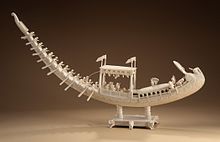
Back النهضة البنغالية Arabic বংগৰ নৱজাগৰণ Assamese Бенгалско възраждане Bulgarian বাংলার নবজাগরণ Bengali/Bangla Renaixement bengalí Catalan Bengalische Renaissance German Bengalia renesanco Esperanto Renacimiento bengalí Spanish Bengaliar Pizkundea Basque رنسانس بنگالی Persian
| Part of a series on the |
| Culture of Bengal |
|---|
 |
| History |
| Cuisine |
| Part of a series on |
| Bengalis |
|---|
 |
The Bengal Renaissance (Bengali: বাংলার নবজাগরণ, romanized: Bāṅlār Nôbôjāgôrôṇ), also known as the Bengali Renaissance, was a cultural, social, intellectual, and artistic movement that took place in the Bengal region of the British Raj, from the late 18th century to the early 20th century.[1] Historians have traced the beginnings of the movement to the victory of the British East India Company at the 1757 Battle of Plassey, as well as the works of reformer Raja Rammohan Roy, considered the "Father of the Indian Renaissance," born in 1772.[2] Nitish Sengupta stated that the movement "can be said to have … ended with Rabindranath Tagore," Asia's first Nobel laureate.[3]
For almost two centuries, the Bengal renaissance saw the radical transformation of Indian society, and its ideas have been attributed to the rise of Indian anticolonialist and nationalist thought and activity during this period.[4] The philosophical basis of the movement was its unique version of liberalism and modernity.[5] According to Sumit Sarkar, the pioneers and works of this period were revered and regarded with nostalgia throughout the 19th and 20th centuries, however, due to a new focus on its colonialist origins, a more critical view emerged in the 1970s.[6]
The Bengali renaissance was predominantly led by Bengali Hindus,[7] who at the time were socially and economically more affluent in colonial Bengal, and therefore better placed for higher education as a community. Well-known figures include the social reformer Raja Rammohan Roy, writer Rabindranath Tagore, and the physicist Satyendra Nath Bose. The main Muslim figures in the movement include members of the Suhrawardy family, poet and musician Kazi Nazrul Islam and writer Rokeya Sakhawat Hussain.[8]
- ^ Cite error: The named reference
Dasgupta2011was invoked but never defined (see the help page). - ^ Samanta, Soumyajit (2008). The Bengal Renaissance : a critique (PDF). 20th European Conference of Modern South Asian Studies Manchester (UK), 8th – 11th July 2008. p. 2. Archived (PDF) from the original on 5 February 2022.
- ^ Sengupta, Nitish (2001). History of the Bengali-speaking People. New Delhi, Delhi: UBS Publishers' Distributors. p. 211. ISBN 978-81-7476-355-6.
- ^ Panikkar, K N (3 March 2017). "Three phases of Indian renaissance". Frontline. Publishing Private Limited. The Hindu Group. Archived from the original on 28 April 2021. Retrieved 19 April 2021.
- ^ Sartori, Andrew (2009). Bengal in Global Concept History. Chicago: University of Chicago Press. p. 68.
- ^ Sarkar, Sumit (1997). Writing Social History. Delhi: Oxford University Press. p. 104.
- ^ Naranyan Dhar, Pulak (1987). "Bengal Renaissance: A Study in Social Contradictions". Social Scientist. 15 (1): 26–45. doi:10.2307/3517400. JSTOR 3517400.
- ^ De, Amalendu (April–June 1995). "The Social Thoughts and Consciousness of the Bengali Muslims in the Colonial Period". Social Scientist. 23 (4/6): 16–37. doi:10.2307/3520213. JSTOR 3520213.